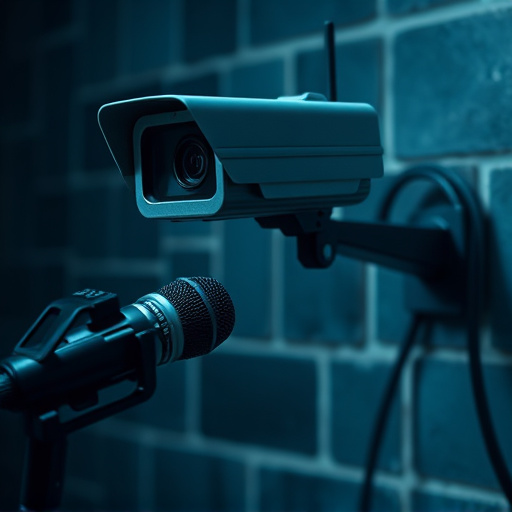Spy cameras and microphones have evolved significantly, becoming smaller, more advanced, and nearly undetectable. Integrated into everyday objects like clocks or plants, these devices capture high-quality video and sound, enhancing security measures for homes and businesses. While they offer enhanced safety, their widespread use raises legal and ethical concerns regarding privacy. Balancing security needs with individual freedoms requires understanding of legal obligations, public awareness, and proactive security measures to combat covert surveillance threats in the digital age.
In an era where privacy is increasingly scrutinized, surveillance audio via spy cameras and microphones has emerged as a complex issue. This technology, hidden in plain sight, raises critical questions about personal privacy and security. From understanding the sophisticated capabilities of modern spy devices to navigating legal and ethical dilemmas, this article delves into the rise of surveillance audio and its profound implications in today’s interconnected world. We explore methods to detect and counter these hidden threats, offering insights for individuals and organizations alike.
Understanding Spy Cameras and Microphones: Unveiling the Technology
Spy cameras and microphones have evolved significantly, becoming smaller, more sophisticated, and easier to conceal than ever before. These devices are designed for discreet surveillance, offering users the ability to capture high-quality video and audio footage without drawing attention. At their core, spy cameras typically feature compact sensors and lenses capable of recording clear images even in low-light conditions. They can be hidden within everyday objects like clocks, potted plants, or smoke detectors, making them nearly impossible to detect.
Microphones, on the other hand, play a crucial role in enhancing audio capabilities of these devices. Miniaturized MEMS (microelectromechanical system) microphones are commonly used, which can capture sounds with remarkable clarity despite their tiny size. These microphones are often integrated directly into the spy camera assembly, allowing for silent and unobtrusive recording of conversations or ambient noise. Advanced signal processing algorithms further improve audio quality, ensuring even faint sounds can be discerned.
The Rise of Surveillance Audio: Why It Matters in Today's World
In today’s world, surveillance audio has become an increasingly ubiquitous aspect of our daily lives. The integration of advanced spy cameras and microphones into various devices and spaces has transformed how we perceive security and privacy. From home monitoring systems to corporate security measures, these technologies offer enhanced safety and peace of mind. With the rise of remote work and online interactions, ensuring secure communication has become paramount, making surveillance audio a game-changer in data protection.
The demand for discreet and efficient spy cameras and microphones has led to remarkable innovations in technology. These devices can now capture high-quality audio and video with minimal detection, enabling better observation and recording capabilities. As our world becomes more digital, the importance of surveillance audio in maintaining order, preventing crimes, and safeguarding sensitive information cannot be overstated.
Legal Considerations and Ethical Dilemmas: Navigating Privacy Laws
In the age of advanced technology, surveillance audio equipped with spy cameras and microphones has become increasingly accessible, raising significant legal considerations and ethical dilemmas. Privacy laws vary across jurisdictions, creating a complex landscape for individuals and organizations deploying such devices. One of the primary concerns revolves around the right to privacy, with strict regulations governing the recording and use of personal conversations and activities without explicit consent. Non-compliance can lead to severe legal repercussions, including fines and damage to reputation.
Additionally, the covert nature of spy cameras and microphones blurs the lines between public and private spaces, leading to debates about reasonable expectations of privacy. Ethical dilemmas emerge when balancing security needs with individual freedoms. It is crucial for users to understand their legal obligations, respect personal boundaries, and adhere to ethical standards to avoid potential legal pitfalls and maintain societal trust.
Detecting and Countering Spy Devices: Staying Ahead in a Complex Landscape
In today’s digital era, the proliferation of sophisticated spy devices like hidden cameras and microphones poses a significant challenge for privacy and security. Detecting these concealed surveillance tools has become an intricate task, as their design often blends seamlessly with everyday objects, making them hard to identify. From compact USB drives that double as listening devices to subtle camera lenses embedded in everyday items, the landscape of spy technology is complex and ever-evolving.
Staying ahead of this threat requires a multi-faceted approach. Regularly updating security protocols and employing advanced detection technologies are essential steps. This includes utilizing specialized equipment for signal scanning and analyzing potential audio or visual anomalies. Additionally, educating individuals about the various forms these devices can take is crucial. By staying vigilant and adopting proactive measures, we can counter the use of spy cameras and microphones, ensuring a safer and more secure environment in both personal and public spaces.
